14 Day Senegal, Gambia and Guinea Bissau
The African West Coast
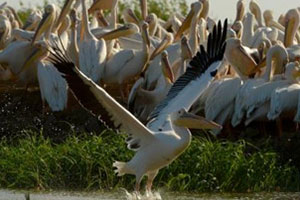
Duration: 14 days
Area: Senegal, Gambia and Guinea Bissau
Style: cultural tours
Comfort Level:![]()
![]()
![]()
![]()
![]()
SENEGAL, GAMBIA AND GUINEA BISSAU
The African West Coast
14 DAYS/13 NIGHTS

A unique itinerary crossing three countries “north to south” to experience a continuous change of climatic ecosystems and human environments.
NATURE
Following the “uncertain border” between land and water we move across an incredible variety of natural environments such desert dunes, savannah, estuaries, forest, mangrove swamps, ending with an exciting ocean navigation to discover and enjoy the Bijagos Archipelago. Birds will be a constant presence along the whole journey. Djoudj National Sanctuary in Senegal is one of the main migratory bird sanctuaries on earth and Gambia is a well-known birding destination.
HISTORY, PREHISTORY & TIMELESS VILLAGES
We will discover historical sites as:
Dakar, contemporary metropolis, large capital and African intellectual center since the time before the independence. Gorée, ancient slave-trade island;
Saint Louis, the first colonial capital of “French West Africa”;
Bolama, the Portuguese Guinea capital, today forgotten in a remote island;
We will experience the encounter with “timeless” people as herders and remote villages. We will discover the largest monoliths site on earth.
ART, CULTURE & MUSIC
In the northern Savannah, we will be invited to the camp of nomadic herders, and we will meet the largest religious and peaceful brotherhood that practices an African form of Islam that rejects fundamentalism and violence.
In the south, we will be introduced to animistic traditional religions, tribal kings, dancing masks, and remote tribes who still worship ancestor statues: a unique chance to enjoy tribal art in its original contest. In the animistic Casamance region, we will witness the celebrations of Diola mask, the incarnation of mythical spirits… Masquerade is a unique experience that involves the participation of the entire village in an intense mix of magic, music, and dances.
TRANSPORTS
We will travel in different kinds of vehicles; each one chosen to optimize the different geographical and cultural environments and have fun. On the land we will travel mainly on comfortable air-conditioned minibus and for short rides we will experience 4WD vehicles, traditional calash, as in option donkey chariot and local taxi.
On the ocean, to the Bijagos archipelago, we will sail on modern speedboats.
UNIQUE EVENT
Turtles’ nesting. Poilao Island in Bijagos Archipelago is an uninhabited site of great beauty. It is also considered the main nesting site for the great Green Sea Turtle (Chelonia Midas) in West Africa. After dark, in silence on the beach, we wait for the magic moment when a female emerges from the ocean and dig the deep hole where she then lays her eggs. With a bit of luck, there are good chances we will be able to witness this natural wonder of nature and/or the hatching! … with the tiny ones coming out of the sand to jump in the ocean and begin a long journey that will take them back to this same island when they reach sexual maturity, 30 years afterward.
| Day 1 | Arrival in Dakar (Senegal) and transfer to the hotel. |
| Day 2 | Dakar contemporary metropolis & Gorée, from Dakar to Gorée - Senegal |
| Day 3 | Lac Rose and fisherman villages, from Gorée to Lompoul - Senegal |
| Day 4 | Saint Louis - Senegal |
| Day 5 | Bird sanctuary & Nomadic tribes - Senegal |
| Day 6 | Tuba Brotherhood - Senegal |
| Day 7 | Stone circles, from Kabacoto to Banjul - Senegal - Gambia |
| Day 8 | Gambian birds and sacred masks from Banjul to Ziguinchor - Gambia - Senegal |
| Day 9 | Sacred kings, Casamance - Senegal |
| Day 10 | Ancestors, Ziguinchor to Quinhamel - Senegal - Guinea Bissau |
| Day 11 | From the ghost capital to the Bijagos Archipelago - Guinea Bissau |
| Day 12 | Special event (speed boat) - Guinea Bissau |
| Day 13 | Islander life (speed boat) - Guinea Bissau |
| Day 14 | From Rubane to Bissau (speed boat) - Guinea Bissau |
Detailed Itinerary
Day 1: Dakar, the capital - SENEGAL
Arrival in Dakar and transfer to the hotel.
Meals: Free
Overnight: Hotel Djoloff, hotel de charme with fine traditional architecture and comfort, or similar (air-conditioned, en-suite rooms).
Day 2: Dakar contemporary metropolis & Gorée, from Dakar to Gorée (transfers in town and ferry) - SENEGAL
Dakar, the large and vibrant African metropolis that was the cultural and intellectual capital of French West Africa. Reflecting that period, the Presidential Palace and the IFAN Museum (Institut Francais d’Afrique Noire), hosting an important collection of African art objects. When it opened, the museum was directed by Theodor Monod, a celebrated Africanist and one of the greatest Sahara scholars. The museum is currently under reconstruction and so the visit will take place if it is open.
We will visit the Musée des Civilisations Noirs. Opened in December 2018, it is the realisation of Léopold Sédar Senghor’s vision (the first president of independent Senegal, a poet, and Nobel Prize winner). The museum represents the historical and contemporary worldwide cultures, art and soul of Black people, which he called Negritude.
We will also see the Cathédrale Notre Dame des Victoires & Place de Souvenirs. The cathedral dates from 1936 and was built in Neo-Sudanese style, a style inspired by the Sahara and Sub-Sahara adobe mosque architecture.
Arrival at Dakar port to board a ferry and spend a night in Gorée, the island where slaves used to be crammed before being shipped to the Americas. Some restored buildings remain to bear witness of those times.
The Portuguese were the first to establish a presence on Gorée in 1450, where they built a small stone chapel. After the decline of the slave trade from Senegal in the 1770s and 1780s, the island became an important port for the shipment of peanuts, Arabic gum, ivory, and other products of legitimate trade. Thanks to the nice breeze, and the many restaurants and shops, Gorée today has become a pleasant and trendy location. In late afternoon and evening, when the other tourists are gone, we will experience the real feeling of this special island.
Meals: B - L - D
Overnight: Hotel “de charme”, capacity of hotels in Gorée is limited. The group may be split in different locations, close each other (air-conditioned, en-suite rooms).
Day 3: Lac Rose and fisherman villages, from Gorée to Lompoul (ferry and drive 170 km – 6 hrs) - SENEGAL
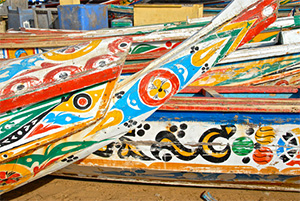 Waking up in Gorée before the crowd arrives is a pleasure, as strolling in the tiny stone paved alleys of this historical settlement.
Waking up in Gorée before the crowd arrives is a pleasure, as strolling in the tiny stone paved alleys of this historical settlement.
Ferry to Dakar and drive to Lac Rose, a shallow saltwater lake surrounded by dunes, also known as Lac Retba. The water is ten times saltier than in the ocean and thanks to this high concentration the lake often shimmers into pink. Workers here collect salt in the traditional way.
Miles of exciting drive on the beach by 4x4 will bring us to discover the largest fisherman village in Senegal. More than 4500 wooden painted pirogues come to the shore with the catch of the day… We will leave our vehicles for a less intrusive, but fun, donkey chariot to approach the fisherman selling to the local market women, to meet the artisans carving the large pirogues, the painters decorating them with bright colors and if we are lucky the “local saint” for final blessing before sailing…
Drive by minibus to the north. At the edge of Lompoul Desert, some 4WD vehicles will be waiting to cross the dunes and take us at our fix camp. The Lompoul orange sand dunes landscape anticipate the neighbouring Sahara.
Meals: B – L - D
Overnight: Permanent tented camp (comfortable tents with beds and en-suite).
Day 4: Saint Louis, from Lompoul to St. Louis (100 km – 2 hrs)– SENEGAL
Saint Louis, known to locals as Ndar, is a charming ancient town which was a French territory from 1673 until 1895 and the capital of all French West Africa colonies from 1895 until 1902, when the capital was moved to Dakar. From 1920 to 1957, it also served as the capital of the neighboring colony of Mauritania.
It has been the former base of the “Aeropostale” airmail pioneer operation between Europe, Africa and South America. Saint Exupéry, the famous writer, author of “The Little Prince”, was one of Aeropostale pilot following this route.
Located on two islands between Senegal river and the ocean at the southern edge of the Sahara, rich in three centuries of history, cultural background, geography, architecture, Saint-Louis is a “bridge” between the savanna and the desert, the ocean, the river, and the inland, between tradition and modernity, Islam and Christianity, Europe and Africa.
Home to a society with a distinctive lifestyle, Saint-Louis has retained its unique identity. "No one comes without falling in love with the city," proudly say its people who consider Saint-Louis as the birthplace of Senegalese Teranga, the Wolof word for hospitability.
The best way to visit the narrow lanes of Saint Louis is by calash, just as locals do, and walk in the fisherman quarters. Time to stroll in the tiny avenues and enjoy the unique atmosphere of this old town.
We will spend the night at the historic hotel of the town - built in 1895 and now fully renovated - it was here that all Aeropostale pilots use to stay.
Meals: B - L - D
Overnight: Hotel de la Poste or similar (Air conditioned, en-suite rooms).
Day 5: Bird sanctuary & Nomadic tribes, from St. Louis to Ferlo desert (150 km – 4 hrs) – SENEGAL
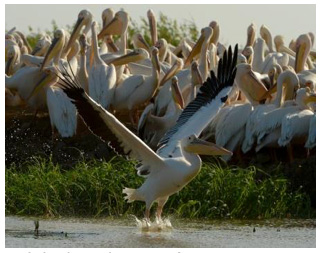 Early morning departure northwards to discover Djoudj National Bird Sanctuary (Parc National des Oiseaux du Djoudj), a natural oasis formed by hundreds of miles of partially flooded lands which has been declared a UNESCO World Heritage Site. This “humid paradise” between the Sahara and Ferlo desert, is the best habitat and nesting site for over a million of migratory and resident birds - lies on the southeastern bank of the Senegal River and offers a range of wetland habitats that are attended by many migrating birds, some getting here after crossing the Sahara. Out of more than 400 species, pelicans and flamingos are the most common, whereas aquatic warblers are a bit less conspicuous - migrating here from Europe, this park is their single most important wintering site yet discovered. Apart from birds there is also a wide range of wildlife such as warthog and crocodiles. Motorboat excursion leaded by a local guide-ornithologist.
Early morning departure northwards to discover Djoudj National Bird Sanctuary (Parc National des Oiseaux du Djoudj), a natural oasis formed by hundreds of miles of partially flooded lands which has been declared a UNESCO World Heritage Site. This “humid paradise” between the Sahara and Ferlo desert, is the best habitat and nesting site for over a million of migratory and resident birds - lies on the southeastern bank of the Senegal River and offers a range of wetland habitats that are attended by many migrating birds, some getting here after crossing the Sahara. Out of more than 400 species, pelicans and flamingos are the most common, whereas aquatic warblers are a bit less conspicuous - migrating here from Europe, this park is their single most important wintering site yet discovered. Apart from birds there is also a wide range of wildlife such as warthog and crocodiles. Motorboat excursion leaded by a local guide-ornithologist.
Depending on the season, considering time of migrations and level of water, the visit to Djoudj may be replace by similar experience in Langue de Barbarie, a thin, sandy peninsula, adjacent to the Atlantic Ocean, located in western Senegal, in the neighborhoods of the city of Saint-Louis. The peninsula separates the ocean from the final section of the Senegal River. The Langue de Barbarie National Park is home to an abundant variety of bird species and three species of turtle, including the critically endangered hawksbill sea turtle.
In the afternoon continuation to the Ferlo Desert to discover the arid region where nomadic Fulani tribe herds large droves of zebu. The Fulani (also called Peul) are the largest nomadic tribe roaming West African Savannahs, living in a vast area from Senegal to Chad. Their origins are still covered with mystery. They all share a common and aristocratic cult for beauty and elegance. In the afternoon a local guide will join us for a visit to the neighboring villages and shelters. When the herds come back, we might even be invited to witness the milking process.
Meals: B - L - D
Overnight: Camp made up of simple grass huts, managed by a local entrepreneur (all rooms with beds, mosquito nets and en-suite).
Day 6: Tuba Brotherhood, from Ferlo desert to Kabacoto (240 km – 5 hrs) - SENEGAL
 The rarely visited holy town of Tuba (Touba) is the right place to appreciate the hospitality of an African brotherhood. Tuba inhabitants follow Mouridism and the town itself is a sort of theocratic “state within the state”, ruled by a Caliph. The founder of Mouridi brotherhood was a Sufi named Amhadou Bàmba Mbake.
The rarely visited holy town of Tuba (Touba) is the right place to appreciate the hospitality of an African brotherhood. Tuba inhabitants follow Mouridism and the town itself is a sort of theocratic “state within the state”, ruled by a Caliph. The founder of Mouridi brotherhood was a Sufi named Amhadou Bàmba Mbake.
Amhadou Bàmba founded Touba in 1887. The holy site remained a tiny, isolated place in the wilderness until his death and burial at the site of the Great Mosque, 40 years later. The Great Mosque was finally completed in 1963 and since its inauguration the city has grown at a rapid pace: from under 5,000 inhabitants in 1964, the population was officially estimated at 529,000 in 2007.
The Mourides have a large social and economic impact in Senegal: thanks to their peaceful (and African) vision of Islam, Mouridism, with other brotherhoods following the cult of Marabouts, has become the bastion that protects Senegal from radical Islam.
During the Grand Magal, annual pilgrimage, the town is visited by four million pilgrims.
Mourides welcome any interest in their traditions. Yet since Tuba is a sacred town, all visitors should accept traditional rules. Therefore, we must apply a considerate dress code: not smoke, not drink alcohol and not listen to music during the visit. If we follow these rules, we will be welcomed. A Baye Fall, a member of a colorful branch of Mouridism, will accompany us during the visit.
Meals: B - L - D
Overnight: Kabacoto Safari Hotel or Relais de Kaolak; air-conditioned bungalows, swimming pool.
Day 7: Stone circles, from Kabacoto to Banjul (240 km – 6 hrs) – SENEGAL-GAMBIA
Early departure, we will leave the main road to discover the unique megalithic site of Sine Ngayene, as part of the Senegambian stone circles, which lies in The Gambia and in central Senegal.
According to UNESCO, the Senegambian stone circles are "the largest concentration of stone circles seen anywhere in the world." These sites represent an extraordinary concentration of more than 1,100 stone and related tumuli spread over a territory of 100 km wide and 350 km in length, in Gambia River north bank.
After The Gambia border formalities, we will drive to Banjul area.
Meals: B - L - D
Overnight: Atlantic hotel, private beach facing the ocean, (air-conditioned, en-suite rooms).
Day 8: Gambian birds and sacred masks from Banjul to Ziguinchor (160 km – 4 hrs) – GAMBIA-SENEGAL
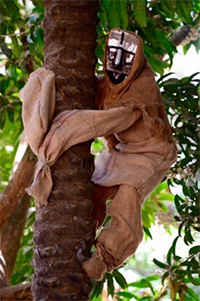 Gambia is renowned as birdwatching destinations. With an ornithological guide we will discover different species of African birds in their habitat.
Gambia is renowned as birdwatching destinations. With an ornithological guide we will discover different species of African birds in their habitat.
Drive to the southern border whit Casamance region of Senegal.
We will leave the main track to join a remote village. We have lunch in the village, prepared by a local family to enjoy the Senegalese gastronomy and improve local community economy.
In the afternoon masks leave the sacred forest to dance for an enthusiastic local crowd. Masks are part of the animistic Diola culture, people fear and respect masks, consider them spirits who play an important role in solving conflicts between villagers.
Evening arrival to our comfortable hotel on the banks of Casamance River where that will be our base for two days dedicated to discover Casamance.
Meals: B - L - D
Overnight: Kadiandoumange Hotel on the banks of the river or similar (air-conditioned, en-suite rooms).
Day 9: Sacred kings, Casamance (150 km aprox – 4 hrs) – SENEGAL
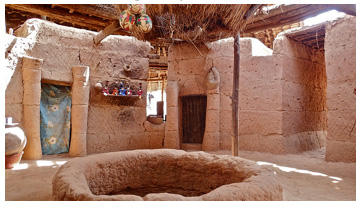 We will leave the main road to visit an adobe-fortified building still inhabited by a large patriarchal Diola family, an interesting example of traditional African sculptural architecture. These large clay and wooden fortified houses, where light comes from a central hole in the roof, are known as “impluvium houses” and had the function to protect its dwellers from outside attacks.
We will leave the main road to visit an adobe-fortified building still inhabited by a large patriarchal Diola family, an interesting example of traditional African sculptural architecture. These large clay and wooden fortified houses, where light comes from a central hole in the roof, are known as “impluvium houses” and had the function to protect its dwellers from outside attacks.
In a hidden village we will be received by the king of a Diola Kingdom. After the protocol salutations the king, that is also the high priest holding both political and mystical power, will answer our questions on the traditional rules in Diola society.
Late afternoon, return to Ziguinchor.
Meals: B - L - D
Overnight: Kadiandoumange Hotel on the banks of the river or similar (air-conditioned, en-suite rooms).
Day 10: Ancestors, from Ziguinchor to Quinhamel (250 km – driving time 7 hrs.) - SENEGAL - GUINEA BISSAU
Early departure for a long but interesting day. Guinea Bissau border crossing.
On the way to Bissau stop at Bula to meet a Manjaco king and learn about the culture of his tribe.
Many Manjaco households within the traditional homeland have an ancestor shrine made up of carved wooden posts which are collectivist representations of ancestors in general. When the Manjaco people make offerings, they refer to a single ancestor despite the shrines represent the ancestors collectively. It is important to note the way in which the Manjaco people consider and “treat” their ancestors in comparison with other cultures. Rather than revering and treating them as guides of moral superiority, the Manjaco people tend to subjugate and incorporate them back into society as relative equals.
Evening arrival to Quinhamel, late dinner.
Meals: B - L - D
Overnight: Hotel Mar Azul, waterfront or similar (en-suite rooms, simple).
Day 11: From the ghost capital to the Bijagos Archipelago, from Quinhamel to Rubane (speed boat) - GUINEA BISSAU
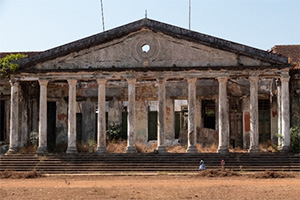 Aboard a speedboat, we start 4 days of sailing to discover the Bijagos Archipelago with its remote islands and isolated human settlements. The Bijagos Archipelago is located approximately 40 miles off-shore and, with its 88 islands (of which only 21 are permanently inhabited), is the largest archipelago in Africa. With its wild and pristine landscapes, its genuine tribal culture and its unique fauna, Bijagos is a “geographical jewel”.
Aboard a speedboat, we start 4 days of sailing to discover the Bijagos Archipelago with its remote islands and isolated human settlements. The Bijagos Archipelago is located approximately 40 miles off-shore and, with its 88 islands (of which only 21 are permanently inhabited), is the largest archipelago in Africa. With its wild and pristine landscapes, its genuine tribal culture and its unique fauna, Bijagos is a “geographical jewel”.
Due to the remoteness of the destination, the lack of transportation and the deep attachment to the local traditions, the Bijagos inhabitants have been little influenced by the external world: during ceremonies women still wear the saiya - a traditional skirt made of straw - and the rhythm of life in villages is given by initiations and secret ceremonies – for example young men have to go through a seven-year initiation rite during which they live in a “convent” without any contact with women.
Our first stop will be Bolama Island, the former capital of Portuguese Guinea from 1871 to 1941, before it was moved to Bissau. This transfer was needed due to the shortage of fresh water in Bolama.
When the Portuguese left, native people came to live in the town which is now falling apart and is partly invaded by tropical vegetation. It was originally built following the plans of a «Castrum Romanum» (roman citadel) so today we can witness its large sunny lethargic avenues, its empty squares, its dry fountains, its bush-like gardens and its large administrative buildings in neo Palladian style. In the Governor’s Palace we can still admire columns in the classic style … where now goats graze! The Bissau-Guinean government is aiming for it to be designated the nation's first World Heritage Site.
Bolama, although inhabited, is plunged in the fairy-tale atmosphere of a still inhabited ghost town.
Arrival on Rubane / Bubaque Islands in the at the comfortable lodge that will be our base for three days of discovering Bijagos Archipelago.
Meals: B - L - D
Overnight: Hotel Ponta Anchaca or Lodge les Dauphins or similar (ocean front comfortable bungalows en-suite).
Day 12: Special event (speed boat) - GUINEA BISSAU
Turtle’s nesting. If the date of the tour is concomitant to the Turtle’s Nesting, special event: visit of the largest village in the archipelago, Bubaque, the only one connected to the continent by a ferry once a week: unpaved alleys, a tiny colorful market, local bars, and traders and the tiny ethnographic museum dedicated to Bijagos culture, sail in the direction of the Southern Island, stop at Meio a pristine uninhabited island where our footprints on the sand will be the only human traces.
Arrival to Poilao uninhabited island, in the night, with high tide the turtles will emerge from the ocean, we must remain silent and don’t use a direct flashlight that can scare the turtles.
Late-night return at our comfortable hotel.
Meals: B - L - D
Overnight: Hotel Ponta Anchaca or Lodge les Dauphins or similar (ocean front comfortable bungalows en-suite).
Day 13: Islander life (speed boat) - GUINEA BISSAU
Day to enjoy the archipelago way of life: relax at the wild beach, a walk to explore villages and luxuriant vegetation, excursion to the neighbor Soga Island. Optional not included: day excursion to Orango Island to watch hippos (actual seeing the hippos is not guaranteed).
Meals: B - L - D
Overnight: Hotel Ponta Anchaca or Lodge les Dauphins or similar (oceanfront comfortable bungalows, en-suite).
Day 14: From Rubane to Bissau (speed boat) - GUINEA BISSAU
Arrival by speedboat in Bissau, the tiny capital of the country. A vehicle will be waiting for us for a brief tour of this tiny and intriguing capital.
We start walking by Bissau Vehlo, the old Portuguese quarter with an atmosphere reminding us of past Portuguese days and where we can experience the mix of African and Portuguese souls. In old wooden cafés, we can taste Portuguese wines and watch Portuguese news. We continue to the Presidential Palace, the Catholic Cathedral, Fortaleza Amura, Independence Monument, and Che Guevara Square to end in an open-air bar known for the best mojito in town.
In the evening, transfer to the airport for the flight out.
Meals: B – L
Day-use: Rooms in day-use (air-conditioning, en-suite rooms)
Day 1: Hotel Djoloff, Hotel de charme, |
|
Day 2: Hotel de charme, |
|
Day 3: Permanent tented camp, |
|
Day 4: Hotel de la Poste or similar, |
|
Day 5: Camp made up of simple grass huts, |
|
Day 6: Kabacoto Safari Hotel or Relais de Kaolak, |
|
Day 7: Atlantic Hotel, |
|
Day 8 - 9: Kadiandoumange Hotel on the banks of the river or similar, |
|
Day 10: Hotel Mar Azul, waterfront or similar (en-suite rooms, simple), |
|
Day 11 - 13: Hotel Ponta Anchaca or Lodge les Dauphins or similar (oceanfront comfortable bungalows, en-suite), |




